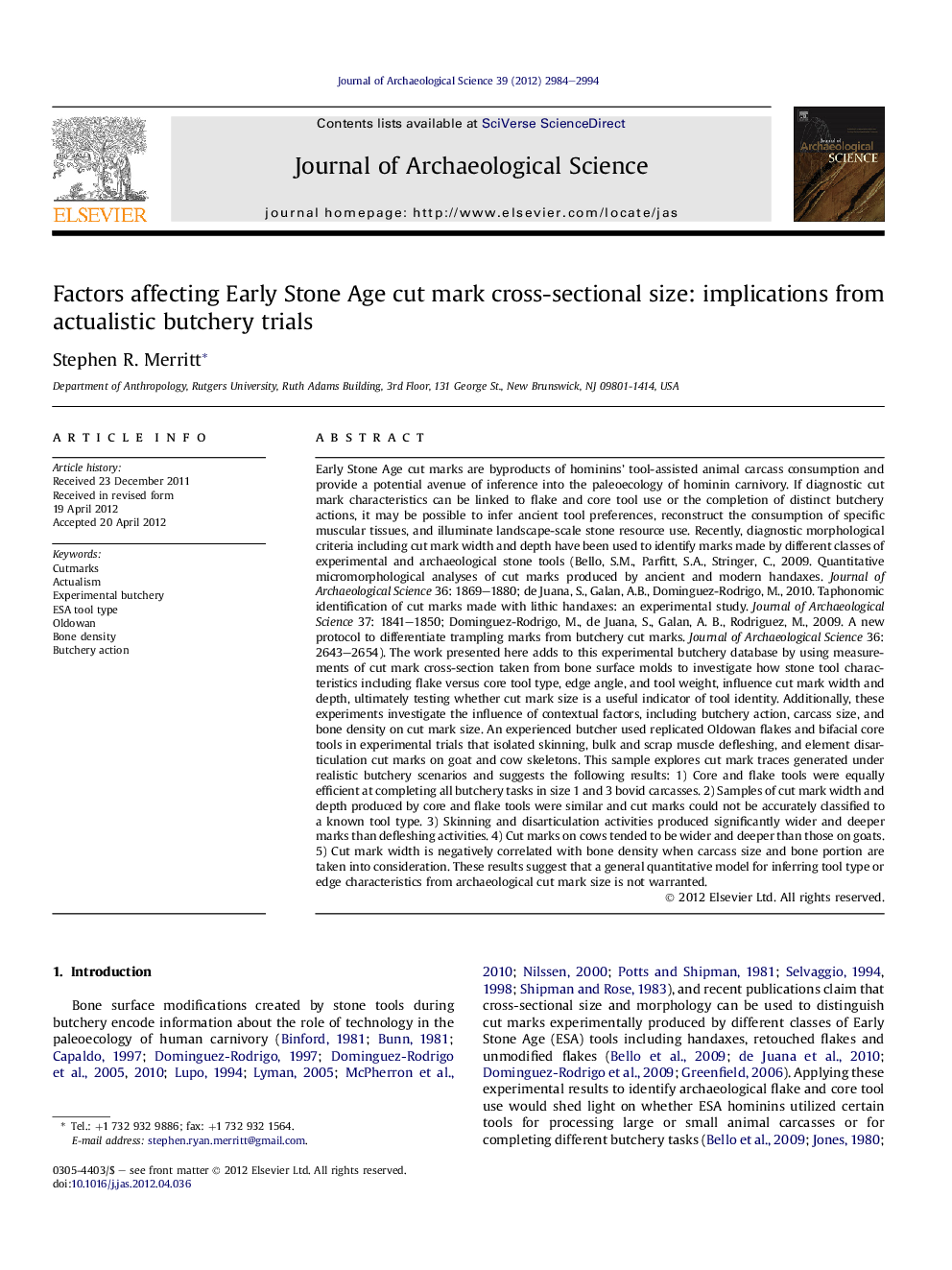| کد مقاله | کد نشریه | سال انتشار | مقاله انگلیسی | نسخه تمام متن |
|---|---|---|---|---|
| 1035800 | 943865 | 2012 | 11 صفحه PDF | دانلود رایگان |

Early Stone Age cut marks are byproducts of hominins' tool-assisted animal carcass consumption and provide a potential avenue of inference into the paleoecology of hominin carnivory. If diagnostic cut mark characteristics can be linked to flake and core tool use or the completion of distinct butchery actions, it may be possible to infer ancient tool preferences, reconstruct the consumption of specific muscular tissues, and illuminate landscape-scale stone resource use. Recently, diagnostic morphological criteria including cut mark width and depth have been used to identify marks made by different classes of experimental and archaeological stone tools (Bello, S.M., Parfitt, S.A., Stringer, C., 2009. Quantitative micromorphological analyses of cut marks produced by ancient and modern handaxes. Journal of Archaeological Science 36: 1869–1880; de Juana, S., Galan, A.B., Dominguez-Rodrigo, M., 2010. Taphonomic identification of cut marks made with lithic handaxes: an experimental study. Journal of Archaeological Science 37: 1841–1850; Dominguez-Rodrigo, M., de Juana, S., Galan, A. B., Rodriguez, M., 2009. A new protocol to differentiate trampling marks from butchery cut marks. Journal of Archaeological Science 36: 2643–2654). The work presented here adds to this experimental butchery database by using measurements of cut mark cross-section taken from bone surface molds to investigate how stone tool characteristics including flake versus core tool type, edge angle, and tool weight, influence cut mark width and depth, ultimately testing whether cut mark size is a useful indicator of tool identity. Additionally, these experiments investigate the influence of contextual factors, including butchery action, carcass size, and bone density on cut mark size. An experienced butcher used replicated Oldowan flakes and bifacial core tools in experimental trials that isolated skinning, bulk and scrap muscle defleshing, and element disarticulation cut marks on goat and cow skeletons. This sample explores cut mark traces generated under realistic butchery scenarios and suggests the following results: 1) Core and flake tools were equally efficient at completing all butchery tasks in size 1 and 3 bovid carcasses. 2) Samples of cut mark width and depth produced by core and flake tools were similar and cut marks could not be accurately classified to a known tool type. 3) Skinning and disarticulation activities produced significantly wider and deeper marks than defleshing activities. 4) Cut marks on cows tended to be wider and deeper than those on goats. 5) Cut mark width is negatively correlated with bone density when carcass size and bone portion are taken into consideration. These results suggest that a general quantitative model for inferring tool type or edge characteristics from archaeological cut mark size is not warranted.
► An experienced butcher used replicated Oldowan tools to butcher goats and cows.
► Stone tool type, butchery action and bone density may affect cut mark cross-section.
► Flakes and cores produce cut marks whose cross-section cannot be discriminated.
► Skinning and disarticulation produce wider and deeper cut marks than defleshing.
► Defleshing cut mark width is negatively associated with bone density per portion.
Journal: Journal of Archaeological Science - Volume 39, Issue 9, September 2012, Pages 2984–2994